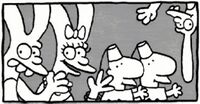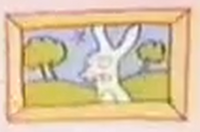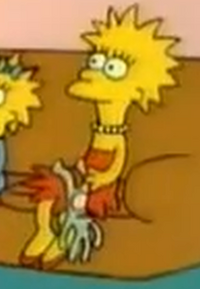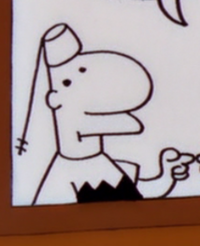
Difference between revisions of "Life in Hell"
(Added more info) |
(Added more info, with sources.) |
||
| Line 10: | Line 10: | ||
'''''Life in Hell''''' was a 1977-2012 weekly comic strip by [[Matt Groening]]. The strip featured a family of anthropomorphic rabbits (father Binky, mother Sheba and son Bongo) and a pair of identical-looking gay lovers (Akbar and Jeff). Groening used these characters to explore a wide range of topics about love, sex, work, and death. His drawings are full of expressions of angst, alienation, self-loathing, and fear of inevitable doom. | '''''Life in Hell''''' was a 1977-2012 weekly comic strip by [[Matt Groening]]. The strip featured a family of anthropomorphic rabbits (father Binky, mother Sheba and son Bongo) and a pair of identical-looking gay lovers (Akbar and Jeff). Groening used these characters to explore a wide range of topics about love, sex, work, and death. His drawings are full of expressions of angst, alienation, self-loathing, and fear of inevitable doom. | ||
| − | ''Life in Hell'' started in 1977 as a self-published comic book Groening used to describe life in Los Angeles to his friends. Groening photocopied and distributed it in a small "punk" corner of the record store in which he worked, Licorice Pizza on Sunset Boulevard. ''Life in Hell'' debuted as a comic strip in the avant-garde Wet magazine in 1978, to which Groening made his first professional cartoon sale. The first strip, entitled "Forbidden Words", appeared in the September/October issue. Popular in the underground, Life in Hell was picked up by the Los Angeles Reader (an alternative weekly newspaper where Groening also worked as a typesetter, editor, paste-up artist and music critic) in 1980, where it began appearing weekly. | + | ''Life in Hell'' started in 1977 as a self-published comic book Groening used to describe life in Los Angeles to his friends. Groening photocopied and distributed it in a small "punk" corner of the record store in which he worked, Licorice Pizza on Sunset Boulevard. ''Life in Hell'' debuted as a comic strip in the avant-garde Wet magazine in 1978 <ref>https://www.lambiek.net/artists/g/groening.htm</ref>, to which Groening made his first professional cartoon sale. The first strip, entitled "Forbidden Words", appeared in the September/October issue. Popular in the underground, Life in Hell was picked up by the Los Angeles Reader<ref>https://www.lambiek.net/artists/g/groening.htm</ref> (an alternative weekly newspaper where Groening also worked as a typesetter, editor, paste-up artist and music critic) in 1980, where it began appearing weekly. |
| − | ''Life in Hell'' reached the attention of Hollywood producer [[James L. Brooks]], who received one strip — "The Los Angeles Way of Death" from 1982. In 1985, Brooks contacted Groening with the proposition of developing a series of short animated skits, called "bumpers", for ''[[The Tracey Ullman Show]]''. Originally, Brooks had wanted Groening to adapt his Life in Hell characters for the show. Fearing the loss of ownership rights to his characters, Groening instead created an entirely new batch of characters, the Simpsons. | + | ''Life in Hell'' reached the attention of Hollywood producer [[James L. Brooks]], who received one strip — "The Los Angeles Way of Death" from 1982. <ref>https://www.lambiek.net/artists/g/groening.htm</ref>In 1985, Brooks contacted Groening with the proposition of developing a series of short animated skits, called "bumpers", for ''[[The Tracey Ullman Show]]''. Originally, Brooks had wanted Groening to adapt his Life in Hell characters for the show. Fearing the loss of ownership rights to his characters, Groening instead created an entirely new batch of characters, the Simpsons. Groening continued ''Life in Hell' until 2012. <ref>https://www.lambiek.net/artists/g/groening.htm</ref> |
==References to ''Life in Hell'' on ''The Simpsons''== | ==References to ''Life in Hell'' on ''The Simpsons''== | ||
| Line 72: | Line 72: | ||
{{TB|[[Season 3|3]]}} | {{TB|[[Season 3|3]]}} | ||
{{TB|34}} | {{TB|34}} | ||
| − | {{TB|"[[Simpsons | + | {{TB|"[[Simpsons Christmas]]"}} |
{{TB|Lisa gets a Binky and Bongo doll.}} | {{TB|Lisa gets a Binky and Bongo doll.}} | ||
{{TBT|}} | {{TBT|}} | ||
| Line 94: | Line 94: | ||
{{TB|"[[Echo Canyon]]"}} | {{TB|"[[Echo Canyon]]"}} | ||
{{TB|Bart and Lisa read 'Life in Hell' comics.}} | {{TB|Bart and Lisa read 'Life in Hell' comics.}} | ||
| − | {{TBT|}} | + | {{TBT|[[File:00 43 Bart's Nightmare.png|200px]]}} |
{{TB|[[Season 3|3]]}} | {{TB|[[Season 3|3]]}} | ||
{{TB|43}} | {{TB|43}} | ||
| Line 219: | Line 219: | ||
{{TB| Maggie plays with a Bongo doll.}} | {{TB| Maggie plays with a Bongo doll.}} | ||
}} | }} | ||
| + | |||
| + | ==Sources== | ||
| + | {{Reflist}} | ||
== External links == | == External links == | ||
Revision as of 04:52, November 9, 2019
Life in Hell
| ||||
Comic Information
|
Life in Hell was a 1977-2012 weekly comic strip by Matt Groening. The strip featured a family of anthropomorphic rabbits (father Binky, mother Sheba and son Bongo) and a pair of identical-looking gay lovers (Akbar and Jeff). Groening used these characters to explore a wide range of topics about love, sex, work, and death. His drawings are full of expressions of angst, alienation, self-loathing, and fear of inevitable doom.
Life in Hell started in 1977 as a self-published comic book Groening used to describe life in Los Angeles to his friends. Groening photocopied and distributed it in a small "punk" corner of the record store in which he worked, Licorice Pizza on Sunset Boulevard. Life in Hell debuted as a comic strip in the avant-garde Wet magazine in 1978 [1], to which Groening made his first professional cartoon sale. The first strip, entitled "Forbidden Words", appeared in the September/October issue. Popular in the underground, Life in Hell was picked up by the Los Angeles Reader[2] (an alternative weekly newspaper where Groening also worked as a typesetter, editor, paste-up artist and music critic) in 1980, where it began appearing weekly.
Life in Hell reached the attention of Hollywood producer James L. Brooks, who received one strip — "The Los Angeles Way of Death" from 1982. [3]In 1985, Brooks contacted Groening with the proposition of developing a series of short animated skits, called "bumpers", for The Tracey Ullman Show. Originally, Brooks had wanted Groening to adapt his Life in Hell characters for the show. Fearing the loss of ownership rights to his characters, Groening instead created an entirely new batch of characters, the Simpsons. Groening continued Life in Hell' until 2012. [4]
Contents
References to Life in Hell on The Simpsons
References in the Tracey Ullman shorts
Episodes
|
References to Life in Hell in the regular seasons
|
Sources
External links
| Wikisimpsons has a collection of images related to Life in Hell. |
- Life in Hell references
 [[wikipedia:{{{1}}} ({{{2}}})|{{{1}}}]] at Wikipedia
[[wikipedia:{{{1}}} ({{{2}}})|{{{1}}}]] at Wikipedia





